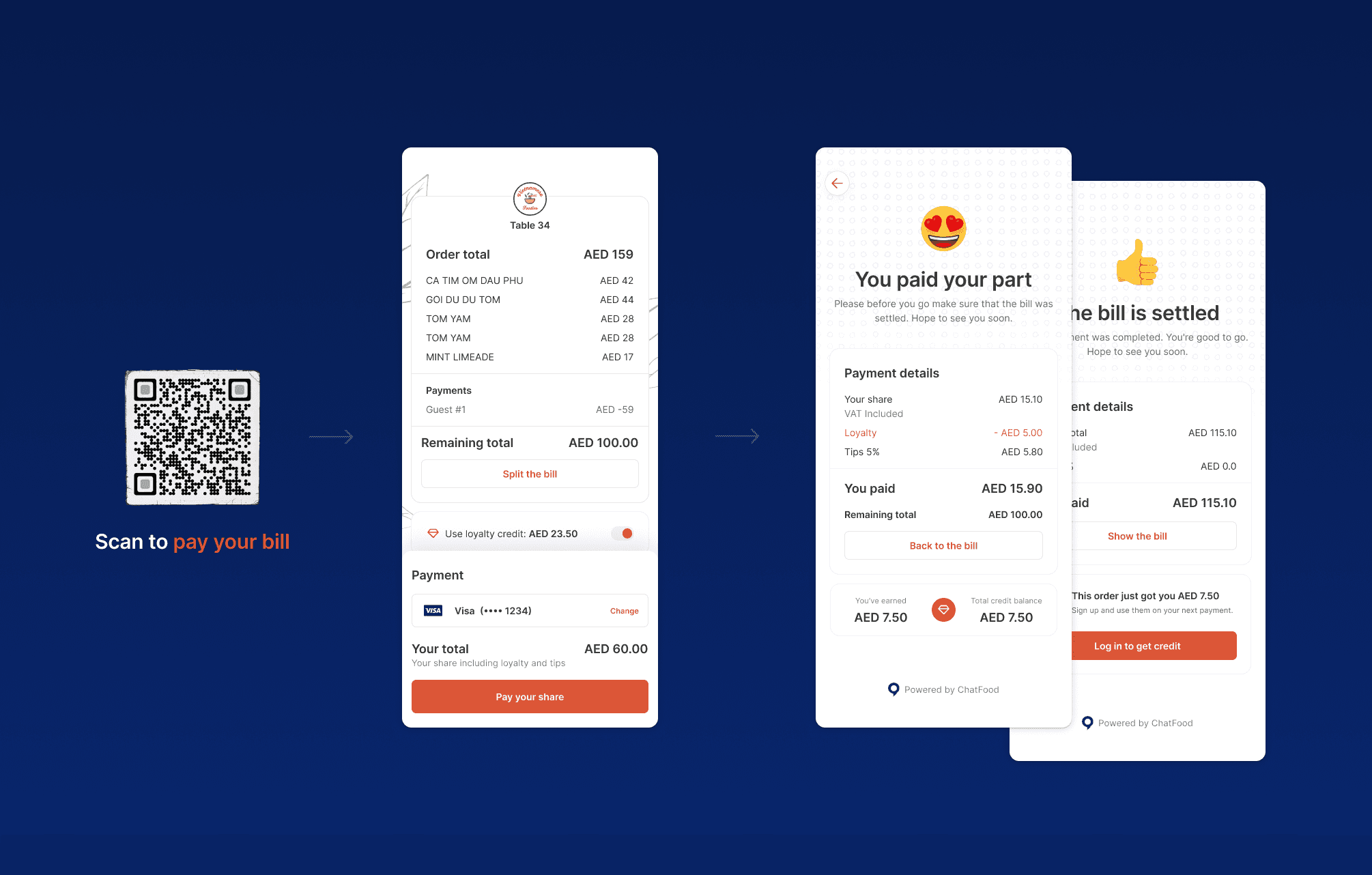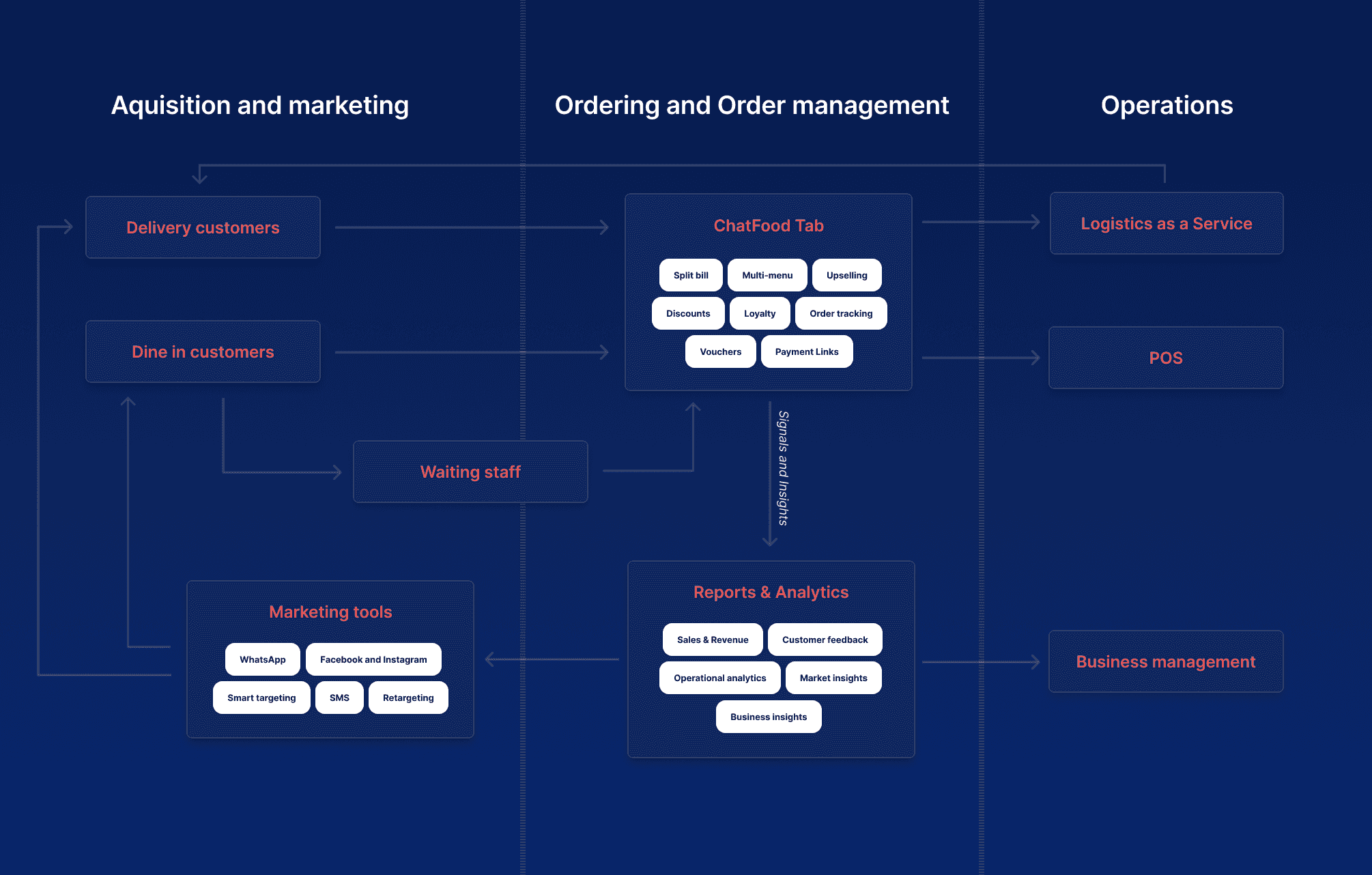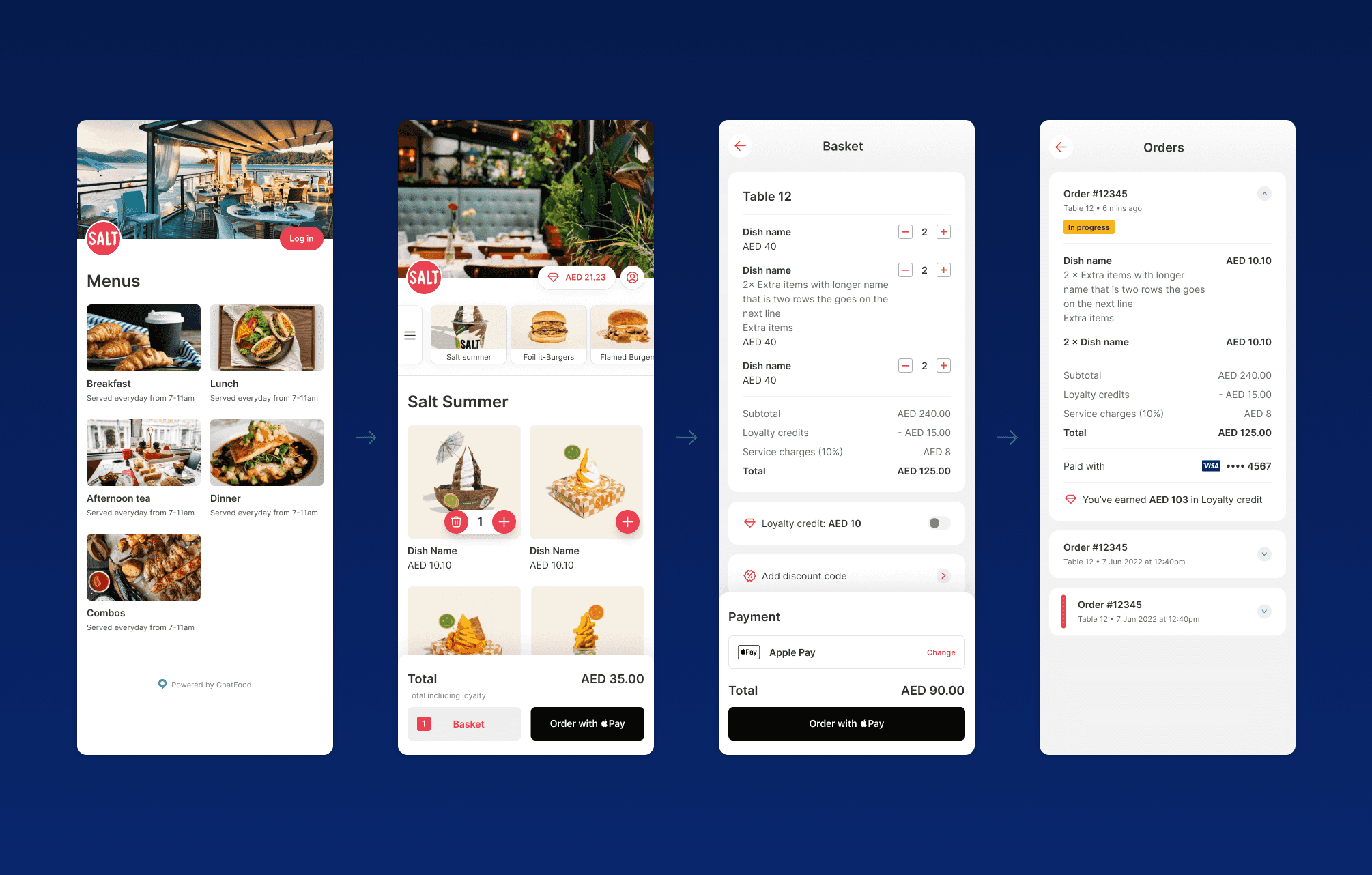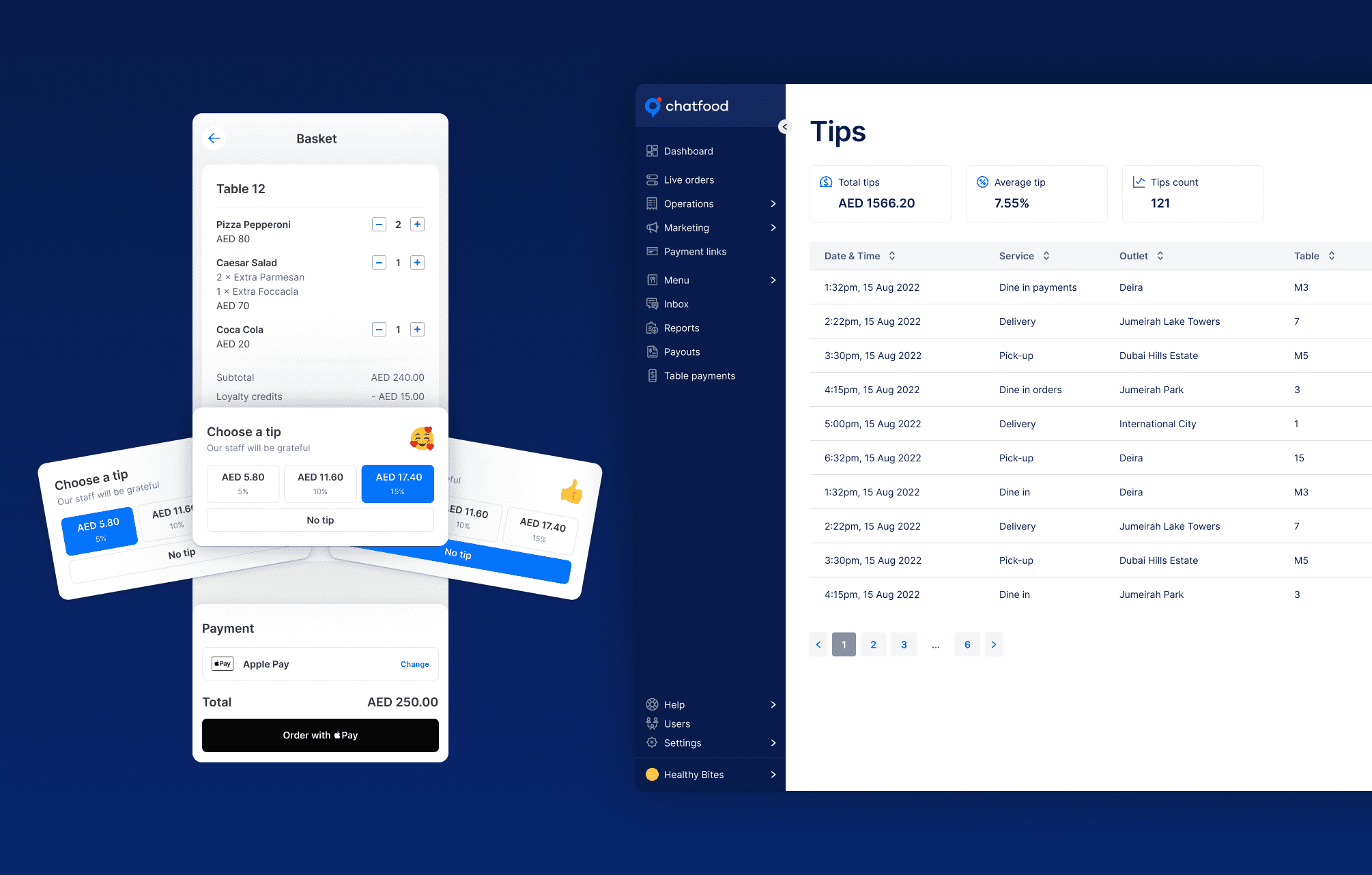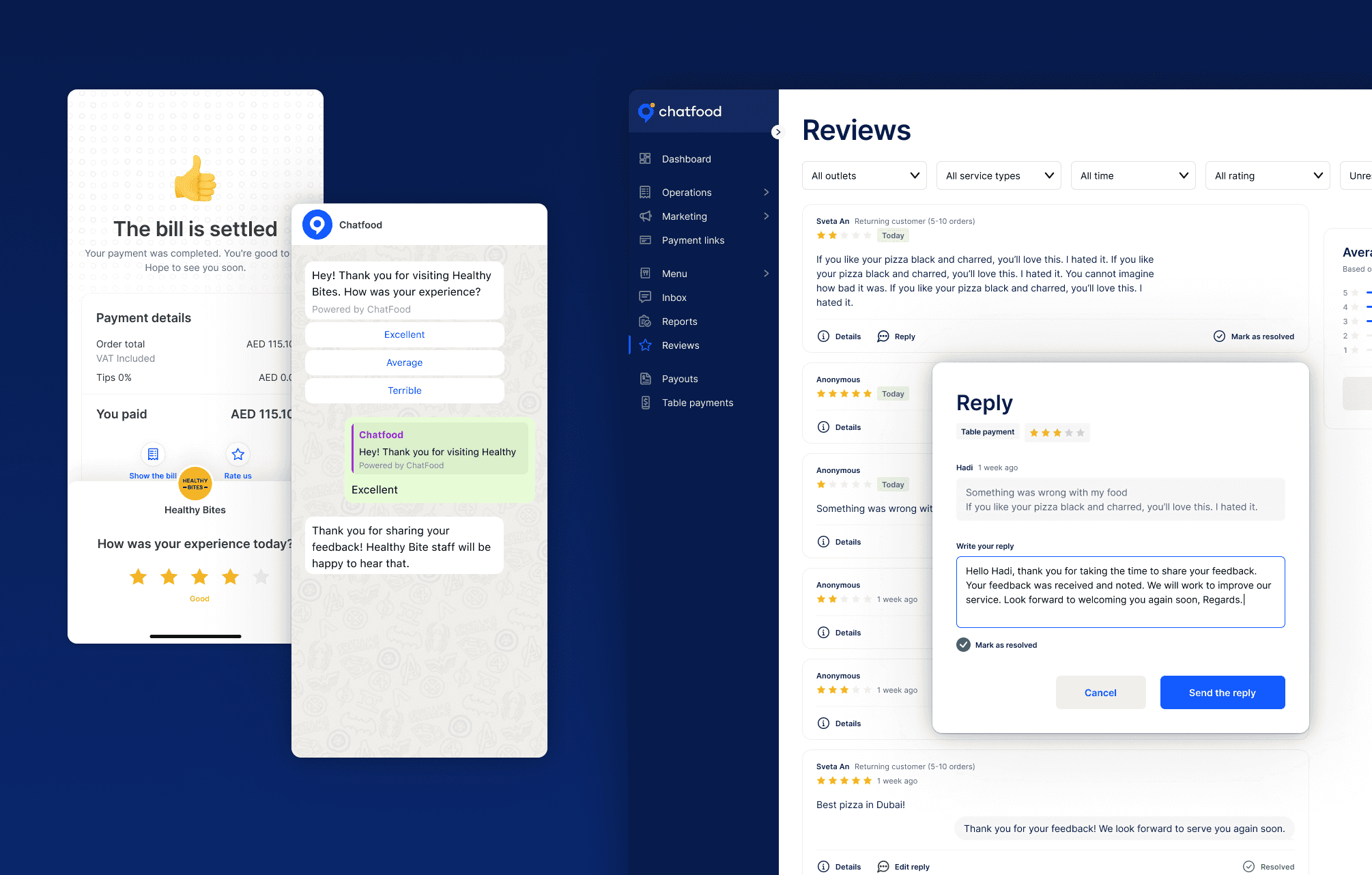ChatFood Dine In
Enable hospitality in a digital world
ChatFood Dine In is an in-store digital order and pay solution for hospitality businesses. Restaurants, hotels, bars and clubs can use Dine In to increase their revenue, optimize their operations, take data based decisions and reduce costs. Their customers also get immediate and high-quality service and communication channel with the business. It was launched in January 2022 and it became over 30% of ChatFood business by September 2022.
My role
I lead strategy, art direction, and day-to-day management of the Product, Product Design and Data teams that launched ChatFood Dine In. The team that brought this to life was composed of around 15 people including Product Managers, Designers and Engineers in the 8 months this case study covers. As head of Product and Product Design, I was responsible of making sure we were working on the right problem, we were finding the right solution and the team build this in an efficient and healthy way.
Background and signals
It all started when lockdowns and restrictions of Covid-19 policies eased up and more and more people wanted to enjoy time outside and with each other. Customers started to gather into off-line spaces with different expectations than before. Since operationally most of restaurants were not ready for the influx, they started looking at digitizing their store and began organically using Chatfood Pickup as an in-store ordering solution.
After exploring this new use case for our product, we realized that this is an untapped market that we could bring value to.
Finding the Product-Market fit
To identify that fundamental value that our product could create, a lot of experimentation, learning and bets needed to be made. Some of these turned out to be viable; most of the times though they were dead ends. But even dead ends left us with knowledge nuggets we could use:
Observation 1: Just paying at the table is not enough value
Our strategy was to first start with a payment only product and then move to a full ordering solution. Patrons would need to order their food and drinks from the waiting staff, but would be able to close and pay their bill independently. When they wanted to leave, they could scan the QR code and see the bill the POS generated and pay online. See [Fig 3].
There were a few competitors on this market from international ones like Sunday to local ones like Qlub and Spades. We quickly learned that just providing table payments is not enough value for users or venue owners; a challenge that competition had too. Customers don't perceive a real issue with waiter availability and payment. On the other hand, owners chase the lowest payment rate possible; the moment you stop giving that to them, they churn.
We managed to launch this experiment in 4 weeks and after we deployed it to a few partners, we realized that this was only half of the solution. Pay At Table does not provide enough stickiness and this could not be a stop-gap to us building a whole Dine In experience. Read more about it in my case study about ChatFood Pay At Table.
Observation 2: The POS world is fragmented and uncooperating
As our product had to sync the bill from the POS, more and more technical difficulties appeared. It started highlighting the unwilligness of POS providers to open up integrations with their software. We had to rely on hacks or half baked solutions to make it work most of the times.
This gave us the courage to take the matter into our own hands and build the end-to-end experience ourselves, agnostic of the POS.
Observation 3: The wait staff is crucial
We hypothesized that if the management has enough conviction in the digital solution, everything else will fall in its place. That proved to be wrong. The understanding that our product is there to help their job and not threaten it was crucial for dealing with staff.
To make sure we were building the right experience, we started collecting staff CSAT score. It became a KPI that we tracked religiously.
Product Vision: a dine-in first solution
Four months after we started experimenting in this market, I was able to gather enough information and market understanding to formulate a Product Vision and Strategy [Fig 4]. It mapped an omni-channel approach, it defined the communication bridge between business onwers and consumers and it provided clear value chain for each actor in the process: the owner/manager, waiting staff and consumer.
To materialize this vision we had already a lot of the puzzle pieces in the journey from our delivery product and now we just had to build on top of that and complete the whole image. The modules that translate seamlesly to dine in were: loylaty, user accounts, discounts, menu management, order management, etc.
But the ordering experience was not easily translatable. We tried to patch it but we soon realized that we needed to start from scratch: a true dine in first ordering experience. An experience that incorporated all the learnings we had.
Multi menu
Restaurants have usually multiple menus: for drinks, for special days, for happy hour and so on. By building in the experience a multi menu foundation — and the proper automation to go with it — saved venues a lot of work and costs with physical menus. It also created opportunities for multi-brand venues and food halls like Social Distrikt, where a customer can order from a multi-kitchen environment.
Quick order and pay
A two-tap one screen approach to ordering. No need for basket, order reviewing or tracking sceens. A customer can order a coffee faster than actually they can utter the words to a waiter. That if the waiter is around.
Tipping
I was mentioning earlier about staff involvement in the success of the product and we took that to heart. Our solution is not meant to replace waiters, but to create an extension of their capabilities; they’re at all the tables at once. And since hospitality needs to be rewarded, we’ve made tipping prominent but not invasive.
For staff to track their earnings was a big driver in the adoption, so we approached tips with a full transparency mindset.
Reviews
The vast majority of restaurant managers do not know outright how the experience in their venue is. They have to rely on either listing to the loud minority of unsatisfied online reviewers or the polite positive answers in the venue.
With ChatFood Dine In we ask customers about their visit and 27% of them decide to rate and comment. We've reached this level of review collection by carefully selecting the channel of review and the time to ask. We are always mixing a set of WhatsApp bots, email questionnaires and at payment questions.
What lies ahead
Looking at the product vision in Fig 4, there area a set of axes that the Product can expand in, offer more value and become stickier.
Order → Enjoy
We’ve started from a online delivery experience. Where you have to select what you want, pay for it, and then enjoy after the order was delivered (Order → Pay → Enjoy). As we've build ChatFood Dine In we’ve emulated a more offline experience where you order your food/drinks, you enjoy them and pay before you leave (Order → Enjoy → Pay). One problem we're looking to solve is getting to an Order → Enjoy experience. One that, knowing who you are, the payment can be automated.
Abstract the POS
As I was mentioning in our findings, the Point of Sale market is very fragmented, resistant to change and has no pulse on consumer behavior. At the same time, no venue manager really loves the software they use now. This is a space where the status quo can be disrupted, abstracted and eventually commodized by a consumer first solutions like ChatFood Dine In.
Relationships, not marketing
Right now, restaurants rely on unsophisticated ways to market their offerings. By using analytics, insights and direct access to consumers, a new communication bridge can be built where the relationships are the ones that drive sales.
Always a regular
This is the nut every restaurant wants to crack. Returning customers are the lifeblood of any successful restaurant — whether you’re a neighborhood joint with locals propping up the bar or a fine-dining restaurant with high-spending celebrity patrons.
At the same time, consumers want to have that sense of personalization, community and routine.
By using technology, a resturant can provide a new customer that regular experience by recommending products already liked, be informed of dietary restrictions or even preffered seating.

